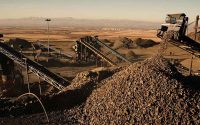Close to 40% of Iran’s decorative stone mines have gone out of business due to the unfavorable economic climate facing the sector, the head of International Affairs Department of Iron Ore Producers and Exporters Association of Iran said.
According to Keyvan Jafari Tehrani, the after-effects of economic sanctions imposed by the West on Iran over its nuclear energy program, which were officially lifted in Jan. 2016 as part of the July 14, 2015, nuclear deal between Iran and world powers, and the restrictions enforced by the government over unprocessed mineral exports weakened Iranian decorative stone’s standing in the international markets.
“Decorative stone exports were banned in 2006 as part of a move to put an end to sales of unprocessed minerals, which dealt a serious blow to the sector. Although the measure was recently revoked for decorative stones, the sector has yet to regain the markets it lost,” IRNA quoted the IROPEX official as saying.
Export of raw minerals has for long been the subject of heated debates among government officials, parliamentarians and miners. Lawmakers consider the export of any form of decorative stones or iron ore–the main minerals under scrutiny–as an instance of raw material sales, arguing that it deprives the economy of a considerable amount of value added.
Miners, however, contend that each stage of processing low-grade minerals creates a certain degree of added value. They say it is not economical, especially for smaller mines, to carry on with processing minerals considering the inadequate infrastructure inside the country.
“No mineral is immediately usable after extraction as it has to undergo several processes before it can be used in any industry,” says managing director of Chadormalu Mining and Industrial Company, Mohammad Nourian.
Tehrani noted that for the past two decades, Iran has consistently been among the world’s top decorative stone producers, but has never been able to secure a fair share in the international markets due to restrictions at home and sanctions, in addition to the global glut.
Iran produces about 17 million tons of decorative stones every year, with annual exports accounting for 4% of the figure valued at nearly $200 million.
This is while the Stone Association of Iran intends to boost decorative stone exports to reach $2 billion per annum by the end of 2020.
According to Tehrani, “nothing will change” until banking transactions with all the major currencies are made possible and Iranian decorative stone exporters start organizing their products under a unified brand.
PMP, or Persian Mining Product, is the branding the official proposes to guarantee “Iranian mineral quality” worldwide and also prevent minerals from other origins being sold under Iran’s name.
Malek Rahmati, deputy chairman of IROPEX, said Iran has fluctuated between the third and fifth places among global decorative stone producers in recent years, but ranks as the 12th global exporter.
“The country has an estimated 8-billion-ton reserve of decorative and construction stones, including 2.3 billion tons of proven reserves while the rest is in probable reserves,” he said, adding that decorative stone mines account for 1,900 of the 7,800 active mines in the country.
Source: Financialtribune





